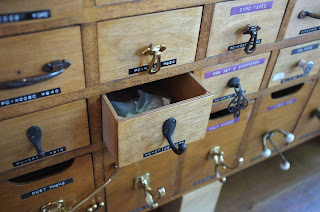It turns out that there are quite a few of these British and European specialty antique businesses in Japan, some of which have show rooms you can visit and many of which also let you shop online.
Here are some of those that I've found.
- http://www.victoriancraft.com/ The amazing show room complex I visited recently in Matsumoto, Nagano. They also do a space planning service, having helped with Royal Scotsman and many Irish bars, cafe spaces and hair salons. (The original perhaps perfect but prohibitively expensive armchair price around 218,000 JPY)
- http://www.winchester.jp/ British antiques (and Mini Cooper cars/car parts) business based in Wakayama and Nara. They also have a Doll's House online shop.. (Armchair price around 119,000 JPY, not directly comparable style)
- http://www.globe-antiques.com/shopinfo/ Ikejiri shop and cafe space in Tokyo, online shop and business planning service. Check out their planning section for a nice gallery of shops they've designed. (Armchair prices around 189,000 JPY)
- http://shop.globe-antiques.com/ Appears to be related to the above site, but the list of items is different, and so I've included it here. (No armchair to compare price)
- http://www.rafuju.jp/ Not only British antiques, apparently a huge stock of items. Based in Ibaraki-ken. (My head hurt trying to find an armchair to compare price. Not exactly comparable styles, but different styles around 20,000-74,000 JPY)
- http://www.british-life.jp/ Tochigi-ken based British antique business with online shop. Appears to focus on tables and cabinets. (Armchair price around 105,000 JPY)
- http://www.antique-flandre.com/ Nagoya-based European antique store with slightly scary fonts on their site and photos of an insane amount of stock. Focus on British, French, Dutch and Belgian furniture. Comparatively competitive prices. (Armchair price around 158,000 JPY)
- http://www.euro-market.jp/ The new 'old fashion style' furniture part of the above business, items work out cheaper than the original antiques. (Armchair price around 96,000 JPY)
- www.robin-fb.co.jp Emphasis on the pretty-pretty, wrought iron garden bits and bobs, ceramics and picture frames. Feels like it is aimed at domestic consumers rather than businesses. Retail premises in Nagano and online store. (Small armchair price around 47,000 JPY, not comparable style)
- http://www.chelsea-old.com/ Beautiful photos of stock on this site. I want all the things! Gifu-based business with a shop and online store. Again, this business feels as though it is targeting individuals rather than commercial customers. (No armchair to compare price, however items on this site are comparatively expensive..)
- http://www.flex-antiques.com/ A "highgrade" (sic) site, with ladies and little girls posing like princesses in some of the photos. Comparatively cheap pricing, and again lots of stock to rifle through. (Armchair price around 97,000 JPY)
- http://www.sokkuriichiba.com/ The 'new antiques' part of the above business. (Hideous photoshop warning!) Also, some of the furniture is in amusingly poor taste. Can I say that? Eeek. (Armchair price around 96,000 JPY)
- http://www.shellys.net/ Fukuoka based shop, online shop and Facebook page. Appears to be a labour of love, with a "photographs of England" section of the site with pics of phone boxes, pub lunches and corner shops :) (Armchair prices around 98,000 - 198,000 JPY)
- http://handle-marche.com/ Fukui-ken business established 1903 selling French and British antique furniture and light fittings. Special focus on leather wingback chairs (Armchair price around 212,000 JPY)
As you can see, prices are generally quite a bit higher than the equivalent you’d expect to pay in the UK. The Chesterfield style leather wingback chair examples seem to cost between 100,000 - 218,000 JPY which is about 600 - 1,400 GBP and you can find comparable items in the UK starting from about 200 GBP. One would expect to pay more for the same thing in Japan since the Japanese businesses have to factor in importing the items, and also probably due to their rare and exotic nature being sold so far away from home. A bit like how some Muji items are 3 times the price they are in Japan.
I’m currently investigating the logistics and cost involved in another option - having a bit of a used furniture spree back home and shipping them to Japan myself. From what I gather, it’s possible to pay for the use of part of a shipping container.
It isn't immediately encouraging that all the shipping/overseas moving companies I've contacted so far have either not replied, or have stopped responding to my mails after I give them an idea of what I’d be looking to ship – perhaps it’s not enough stuff to make it worthwhile for them. Or perhaps they know that the cost would be too high for me and they are giving up on my behalf. I’ll keep trying however, and report back if I find anything interesting out.














































